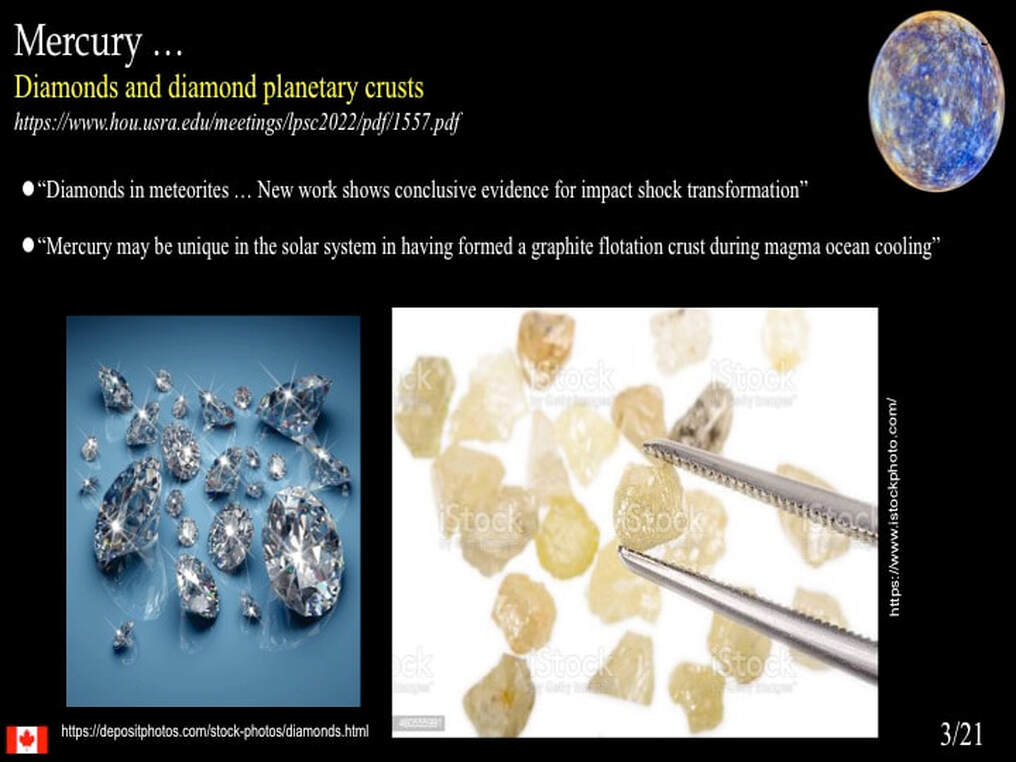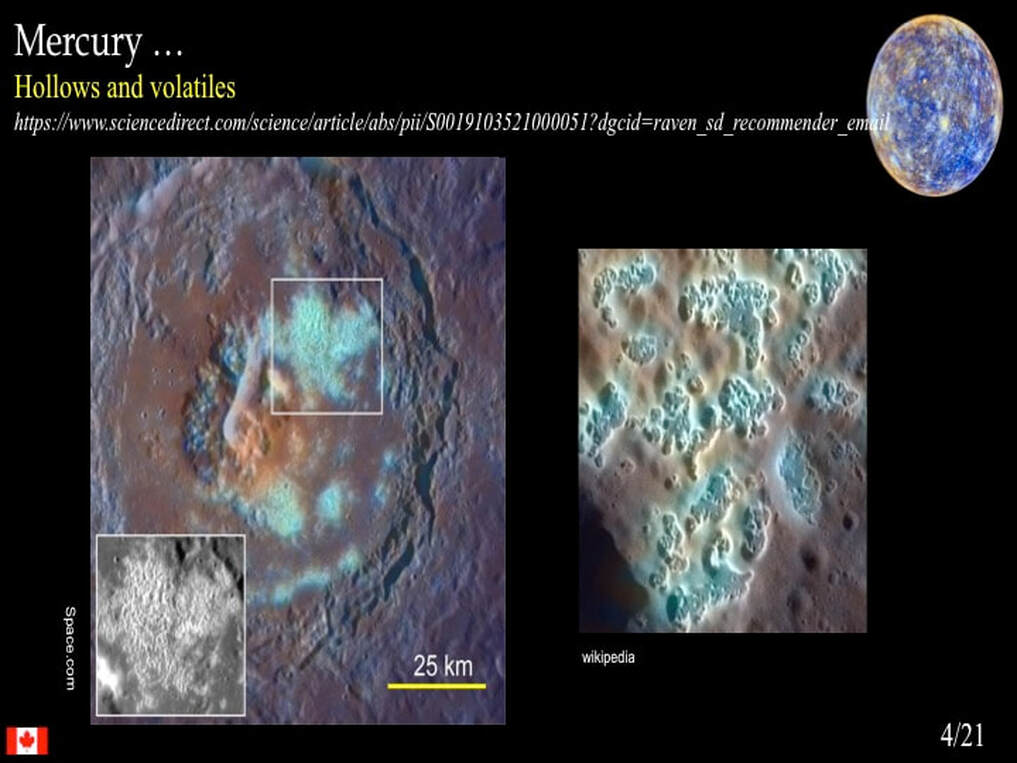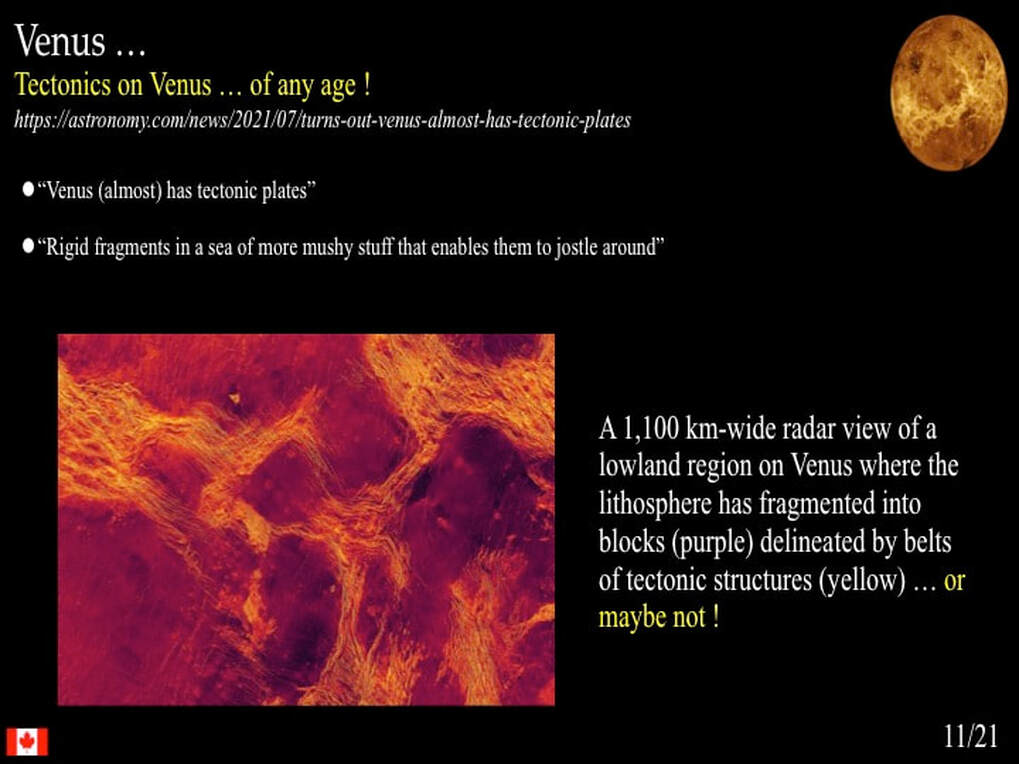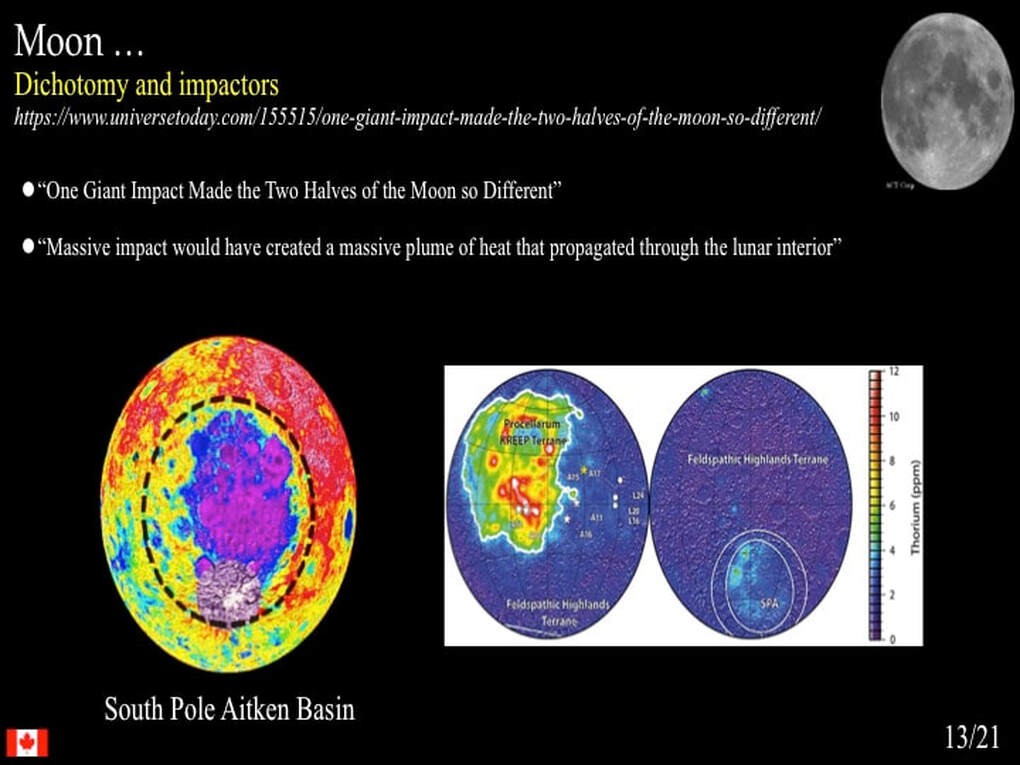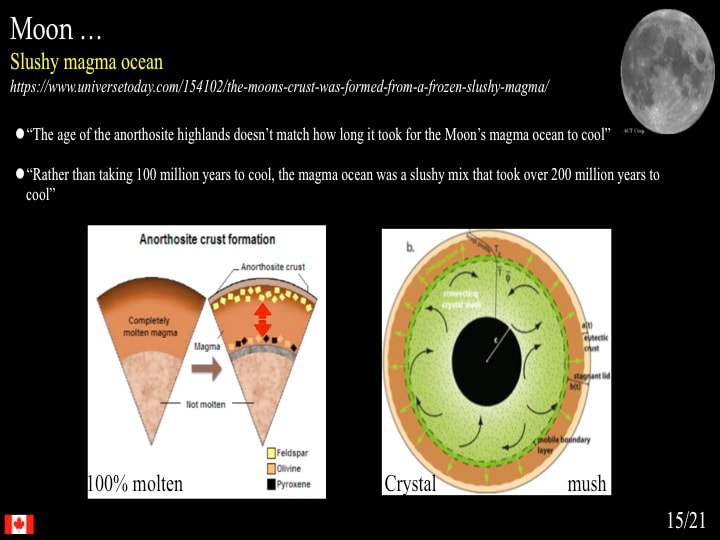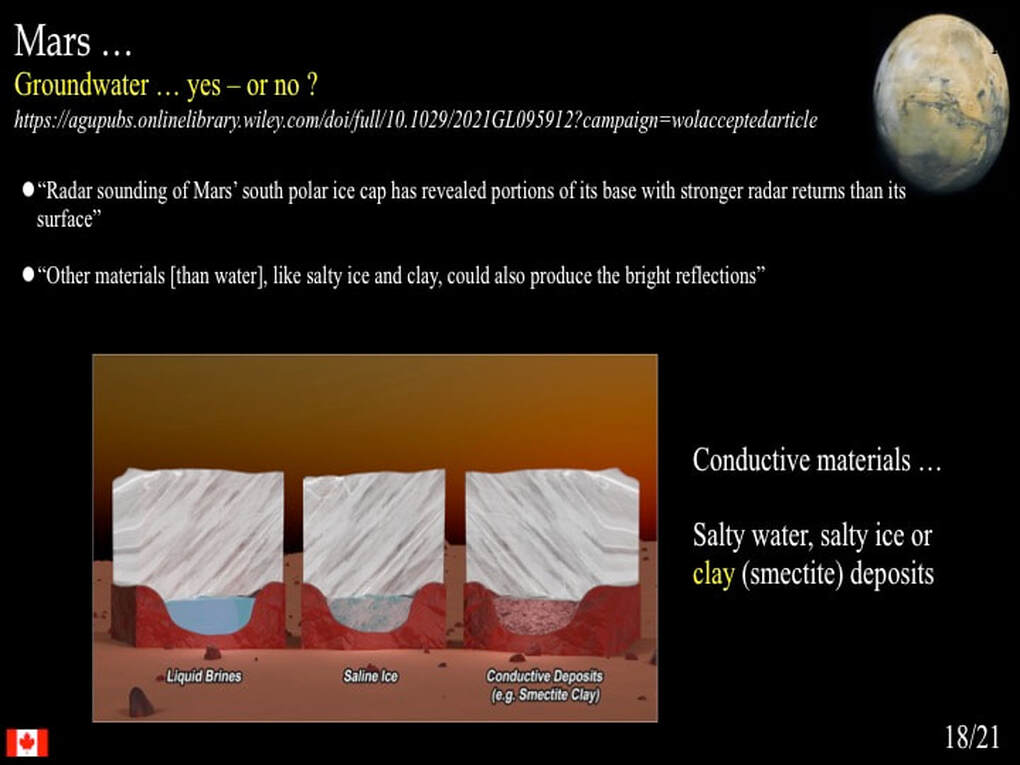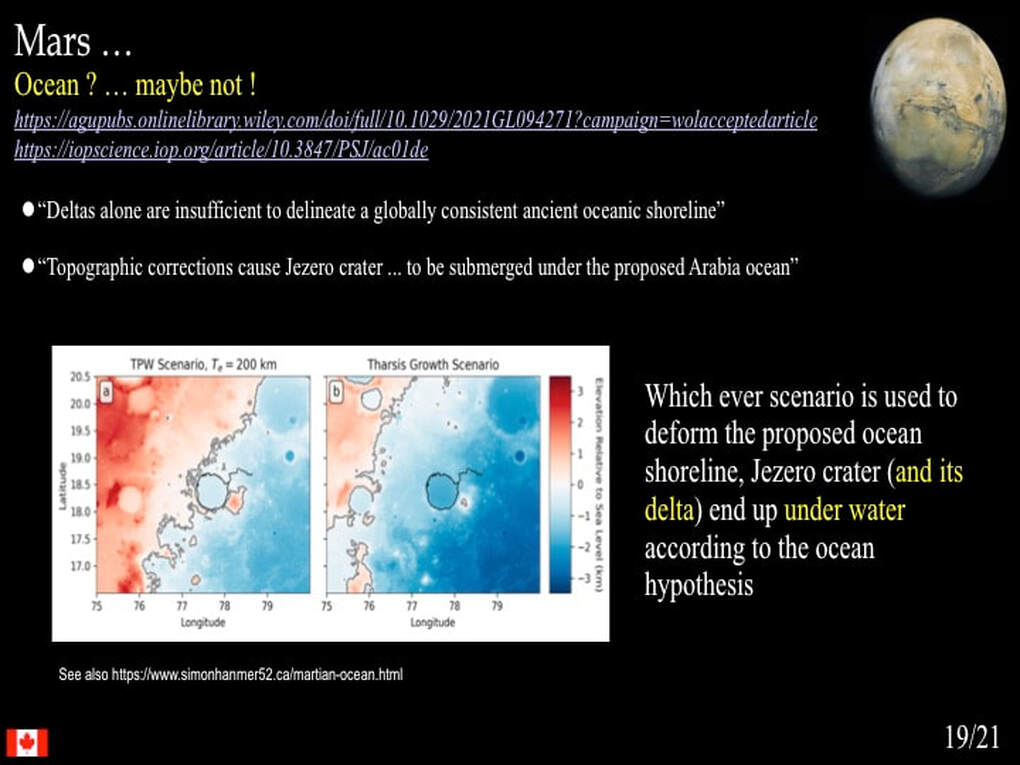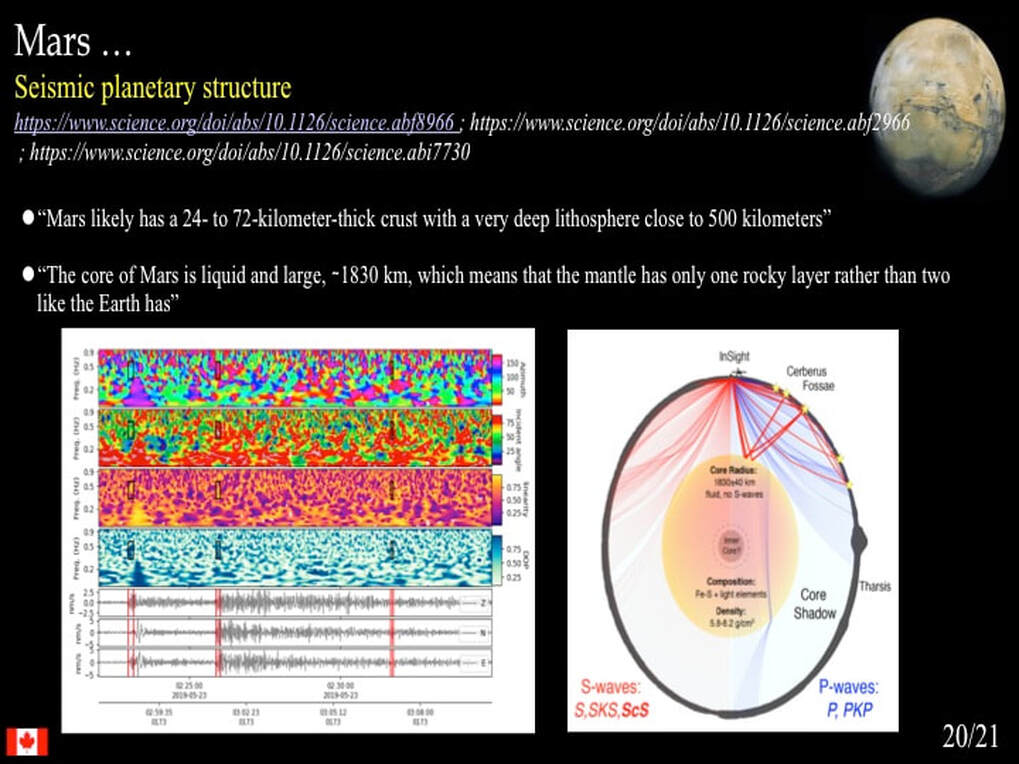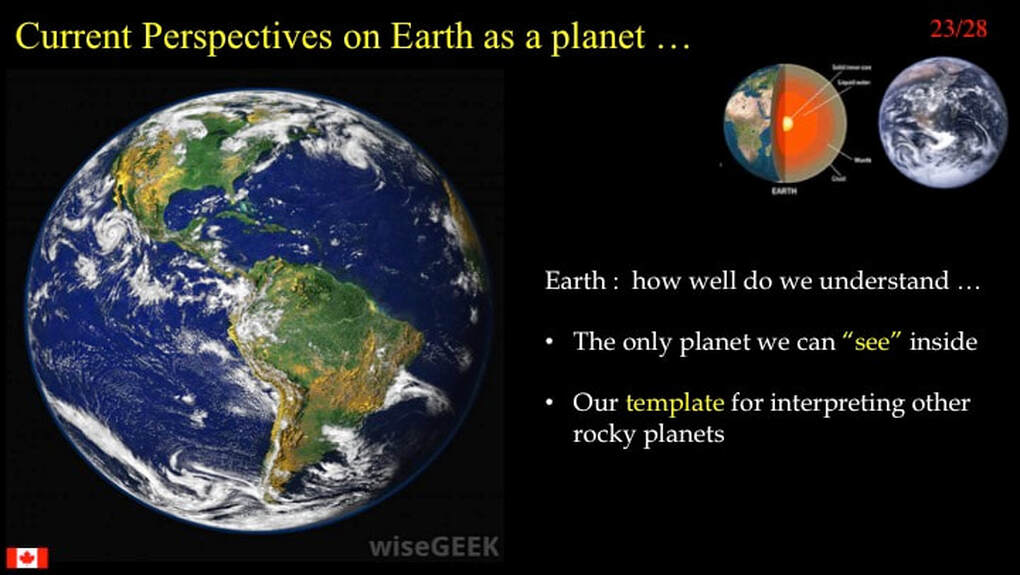|
EARTH as a planet
|
During 2019 and 2020 I have given presentations on the rapidly evolving state of scientific inquiry regarding the Moon (https://www.simonhanmer52.ca/lunar-science-in-2019.html), Mercury (https://www.simonhanmer52.ca/mercury-2019.html), Venus (https://www.simonhanmer52.ca/venus-science-in-2020.html) and Mars (https://www.simonhanmer52.ca/mars-science-in-2020.html), placing a clear emphasis on the big picture and glossing over the details. Today, I'd like to turn the spotlight on the planet that's obviously missing from this list : Earth. It's time for us to look at the Earth as a planet through the eyes of planetary scientists who are discovering it for the first time. So, to ensure that I don't get side-tracked by any of my favourite geological topics, I'm going to change the presentation format tonight and let someone else talk. My here role will be to act as narrator; but narrator of what ?
Narrator of an imaginary tale of planetary exploration by extra-terrestrial planetary scientists who are on their way somewhere else in the galaxy and who, by chance, stumble upon our Solar System. They quickly realise that - as planets go - there's something rather special about the third rock from the Sun. After all it has life ! However, given that they are already behind schedule, they can only spare 30 minutes to check it out - about the same time I have to tell you what they discovered. So to speed things up, they decide to eavesdrop on terrestrial planetary scientists to see what they have discovered about their own planet during the two centuries or so they have been studying it, and to find out where the terrestrials are at in their evaluation of Earth "as a planet" in 2020.
Our extra-terrestrials are pushed for time so they have to focus their inquiry. Given that Earth hosts life, they decide to look to terrestrial planetary scientists for answers to the following big picture questions about this planet :
- How and when did a breatheable planetary atmosphere evolve ?
- How and when did the planetary magnetic field that protects the atmosphere develop ?
- What kind of internal motions generated the magnetic field throughout the history of the planet ?
- Given that the answers to these questions involve the secular cooling of the planetary interior ... including plate tectonics ... how and when did plate tectonics start ...
- ... and when did the continents (that sit on those plates and host the most evolved life forms) develop and grow
They were initially intrigued by these artistic apocalyptic visions of the early Earth, with all the fire and brimstone ! However, these images did not tell them anything about the composition of the early atmosphere, which is important because without atmospheric oxygen there wouldn't be much fire at all !
Our extra-terrestrial explorers soon found out that earth-based scientists are well aware of this and that they have a pretty good understanding of what the early terrestrial atmosphere must have looked like chemically : lots of CO2, Methane (CH4) and Ammonia (NH3) + H2O and even some CO. However, no free oxygen : what's referred to as a reducing environment. Of course, they also know that today's planetary atmosphere is oxidising with lots of free oxygen and less of the reducing stuff. The question is : how and when did the oxidised atmosphere evolve?
Our extra-terrestrial visitors also discovered that most earth-based scientists agree that it happened in a series of steps rather than as a simple progression (time gets younger going right), with the big first step referred to as the Great Oxygenation Event at about 2.5 Ga. The extra-terrestrials found it interesting to watch the evolution of atmospheric oxygen (green curve in diagram on left). They noticed how it rises at ~2.5 Ga, then falls back somewhat and seems to stay at the new level for about 1 Ga (time goes from older to younger from left to right). They also noticed that land plants come in very late in the story. Forests may well be the planetary lungs today, but it was microscopic oceanic bacteria and algae that played that role during most of the oxygenation of the planet's atmosphere.
Our extra-terrestrial visitors also discovered that most earth-based scientists agree that it happened in a series of steps rather than as a simple progression (time gets younger going right), with the big first step referred to as the Great Oxygenation Event at about 2.5 Ga. The extra-terrestrials found it interesting to watch the evolution of atmospheric oxygen (green curve in diagram on left). They noticed how it rises at ~2.5 Ga, then falls back somewhat and seems to stay at the new level for about 1 Ga (time goes from older to younger from left to right). They also noticed that land plants come in very late in the story. Forests may well be the planetary lungs today, but it was microscopic oceanic bacteria and algae that played that role during most of the oxygenation of the planet's atmosphere.
So, how do earth-based planetary scientists know that a Great Oxygenation Event occurred at ~2.5 Ga (again, time gets younger going right) ? Because geologists tell them that before that time there were gravel deposits that contain pyrite (fool's gold) that would have rusted in the presence of atmospheric oxygen, plus Banded Iron Formations (picture) that could only form if the ocean water they formed in was very oxygen poor. After the Great Oxygenation Event, geologists have found lots of rusted red sandstones and shales that are proof of the presence of atmospheric oxygen.
Great, said the extra-terrestrials ... so what's the problem ? The "Boring Billion" ! Immediately after the Great Oxygenation Event, most earth-based planetary scientists envisage a period of about a billion years when not much happens on planet Earth ! According to them, the oxygen level fell back a bit after the Great Oxygenation Event and simply stayed that way until the first recognisable animals start to turn up in the fossil record. However, our extra-terrestrial visitors soon discovered that other planetary scientists see things somewhat differently, starting with the observation that after the Great Oxygenation Event, metals that are particularly sensitive to the presence of atmospheric oxygen turn up in quantities similar to what we find today, suggesting that there was lots of oxygen around after the Great Oxygenation Event. The extra-terrestrials were not sure what to make of all this.
Great, said the extra-terrestrials ... so what's the problem ? The "Boring Billion" ! Immediately after the Great Oxygenation Event, most earth-based planetary scientists envisage a period of about a billion years when not much happens on planet Earth ! According to them, the oxygen level fell back a bit after the Great Oxygenation Event and simply stayed that way until the first recognisable animals start to turn up in the fossil record. However, our extra-terrestrial visitors soon discovered that other planetary scientists see things somewhat differently, starting with the observation that after the Great Oxygenation Event, metals that are particularly sensitive to the presence of atmospheric oxygen turn up in quantities similar to what we find today, suggesting that there was lots of oxygen around after the Great Oxygenation Event. The extra-terrestrials were not sure what to make of all this.
Things got even more complicated when they learned that still other studies show that there was in fact lots of variation in the level of atmospheric oxygen all through the "Boring Billion", which was caused either by biological or geological processes (i.e. weathering), so maybe the Boring Billion wasn't so boring after all ! BTW time gets younger to the right
So, OK, we've got a planetary atmosphere, but atmospheres need a protective shield to prevent erosion by the solar wind. That means a planetary magnetic field, and the big issue here is "just how do you do that ?". I'm pretty sure that you all know that the Earth's magnetic field today is generated by convection in the planet's core. Today, the Earth's core is divided in two parts : a solid inner core that crystallised out of a liquid outer core as the Earth as a planet cooled over geological time. The general idea is that the lower part of the liquid outer core rises because it is hotter and less dense than the upper part of the outer core, and it is this thermally driven convection that - in part - drives the Earth's dynamo. The other part of the driving force for convection is the crystallisation of dense iron (Fe) to form the solid inner core, leaving a less dense liquid residue that can rise : a process known as chemical or compositional convection.
All of this is critical for the planet's atmosphere because the magnetic field deflects the solar wind generated by the Sun that would otherwise strip the lighter gases such as H and O (= H2O) and leave the planet barren. The planet's magnetic field also shields life from the cosmic and other electromagnetic rays emanating from the Sun, and allowed life to develop on the early Earth. This made perfect sense to our extra-terrestrial explorers, so they were surprised to learn that there's a problem.
What's the problem ? Well, it turns out that the early Earth was probably too hot as a planet for a solid core to crystallise and therefore - according to calculations - the core could not have driven a planetary dynamo prior to about 1 Ga. The problem is that some earth-based scientists claim to have evidence for the existence of a planetary magnetic field prior to ~4.0 Ga !
All of this is critical for the planet's atmosphere because the magnetic field deflects the solar wind generated by the Sun that would otherwise strip the lighter gases such as H and O (= H2O) and leave the planet barren. The planet's magnetic field also shields life from the cosmic and other electromagnetic rays emanating from the Sun, and allowed life to develop on the early Earth. This made perfect sense to our extra-terrestrial explorers, so they were surprised to learn that there's a problem.
What's the problem ? Well, it turns out that the early Earth was probably too hot as a planet for a solid core to crystallise and therefore - according to calculations - the core could not have driven a planetary dynamo prior to about 1 Ga. The problem is that some earth-based scientists claim to have evidence for the existence of a planetary magnetic field prior to ~4.0 Ga !
Well, said the extra-terrestrials, what exactly is this evidence ? Zircons !
Zircon (ZrSiO4) forms really tough crystals that crystallise in hot molten magma and then end up in sediments like sandstone when the magmatic (igneous) rock gets eroded. While they are crystallising and cooling, impurities of Fe in the crystals line up with the planetary magnetic field that was present at the time the zircons formed. They also contain traces of uranium (U) that breaks down to lead (Pb) over time, so a zircon crystal in an old sandstone presents us with both a clock and a magnetic compass !
OK, so how do earth-based scientists know that the magnetic field recorded by the zircon crystal isn't due to some later disturbance ? How do they know that it doesn't represent a younger superimposed magnetic field - maybe a very recent magnetic field ? Well, just like there's an app for everything, there's a method to answer that question ! The images on the left show you a zircon crystal (green, surrounded by colourless sand [quartz] grains) in a sandstone at various magnifications down a microscope. We can measure both the age of crystallisation of the zircon crystal and the orientation of the magnetic field that it contains. So, how old is the magnetic field in the zircon grain ? We have no idea ! However, if we looked at lots of zircon grains in our sandstone we can answer that question very easily. Let me illustrate how by analogy with the pebbles in the conglomerate on the right. The pebbles formed by rolling around in water before finally coming to rest in the conglomerate deposit (e.g. a pebble beach) and turning into a rock. Now, imagine that we measure the orientation of the magnetic field contained within each of the pebbles in this picture. If the magnetic field is differently oriented from pebble to pebble then it was imposed on the pebbles BEFORE they ended up in the conglomerate. Hence the planetary magnetic field must be OLDER than the age of formation of the conglomerate. However, if the magnetic fields in the pebbles are all aligned in the same direction, then the magnetism was imposed on the pebbles AFTER they ended up in the conglomerate. Thus, the planetary magnetic field would be YOUNGER than the age of formation of the conglomerate.
So, what about our sandstone with its included zircon grains ? Well the U-Pb clocks in the zircons tell us that the zircons formed at ~4.0 Ga, and the magnetic fields in those same zircons are oriented all over the place - so the Earth's planetary magnetic field is older than the sandstone deposition and is probably the same age as the ~4.0 Ga zircons.
Just a word of warning here … a recent study has suggested that magnetic fields might still be younger than the zircon crystals that contain them due to microcracking and alteration, but our extra-terrestrial visitors decided to set that potential complication to one side for now.
Zircon (ZrSiO4) forms really tough crystals that crystallise in hot molten magma and then end up in sediments like sandstone when the magmatic (igneous) rock gets eroded. While they are crystallising and cooling, impurities of Fe in the crystals line up with the planetary magnetic field that was present at the time the zircons formed. They also contain traces of uranium (U) that breaks down to lead (Pb) over time, so a zircon crystal in an old sandstone presents us with both a clock and a magnetic compass !
OK, so how do earth-based scientists know that the magnetic field recorded by the zircon crystal isn't due to some later disturbance ? How do they know that it doesn't represent a younger superimposed magnetic field - maybe a very recent magnetic field ? Well, just like there's an app for everything, there's a method to answer that question ! The images on the left show you a zircon crystal (green, surrounded by colourless sand [quartz] grains) in a sandstone at various magnifications down a microscope. We can measure both the age of crystallisation of the zircon crystal and the orientation of the magnetic field that it contains. So, how old is the magnetic field in the zircon grain ? We have no idea ! However, if we looked at lots of zircon grains in our sandstone we can answer that question very easily. Let me illustrate how by analogy with the pebbles in the conglomerate on the right. The pebbles formed by rolling around in water before finally coming to rest in the conglomerate deposit (e.g. a pebble beach) and turning into a rock. Now, imagine that we measure the orientation of the magnetic field contained within each of the pebbles in this picture. If the magnetic field is differently oriented from pebble to pebble then it was imposed on the pebbles BEFORE they ended up in the conglomerate. Hence the planetary magnetic field must be OLDER than the age of formation of the conglomerate. However, if the magnetic fields in the pebbles are all aligned in the same direction, then the magnetism was imposed on the pebbles AFTER they ended up in the conglomerate. Thus, the planetary magnetic field would be YOUNGER than the age of formation of the conglomerate.
So, what about our sandstone with its included zircon grains ? Well the U-Pb clocks in the zircons tell us that the zircons formed at ~4.0 Ga, and the magnetic fields in those same zircons are oriented all over the place - so the Earth's planetary magnetic field is older than the sandstone deposition and is probably the same age as the ~4.0 Ga zircons.
Just a word of warning here … a recent study has suggested that magnetic fields might still be younger than the zircon crystals that contain them due to microcracking and alteration, but our extra-terrestrial visitors decided to set that potential complication to one side for now.
This has led some earth-based planetary scientists to suggest that maybe the magnetic field of the early Earth was entirely driven by chemical or compositional convection in the planetary core. To do this they turn the classical dynamo model on its head and propose that Mg-rich minerals crystallised at the top of the liquid core. Since Magnesium (Mg) is less dense than Fe, it rises to the core-mantle boundary and the residual liquid enriched in dense Fe sinks : hence convection and a magnetic field ... but without a thermal contribution. Our extra-terrestrial visitors were quite impressed by this work-around !
However, they quickly learned that there are other ideas on the table too. For example, the Earth's planetary mantle is solid today, though it does convect very slowly. However, what if the lower mantle in the early Earth had been liquid and capable of relatively rapid convection ? Maybe it would have been capable of generating a planetary magnetic field : who knows ? Certainly the extra-terrestrial planetary scientists were perplexed ... and that's putting it mildly !
So, OK - while we're on the topic of convection - this is pretty important stuff. After all, if you are going to prevent a planet from melting due to heat build up from the breakdown of radioactive elements such as U, Thorium (Th) and Potassium (K), you need to get the heat out, and convection of the planetary core and mantle would be important components of that process. Well, having just looked at core convection, our extra-terrestrial visitors turned their attention to the planetary mantle.What do earth-based scientists know about mantle convection within the Earth ? Our visitors soon found that there are two principal schools of thought, both of which are well supported ! One says that the entire mantle is a single convection system with hot plumes rising from the core-mantle boundary up to the planetary crust and cold dense slabs of crust and upper mantle that sink right down to the core-mantle boundary.
The other school of thought says ... no way; which, when you think about it, is confusing even for an extra-terrestrial planetary scientist. First, the upper and lower mantle are not made of the same stuff. Second, the lower mantle is at much higher pressure than the upper mantle and so it is much stiffer, and therefore moves much more slowly. In short, the upper and lower mantle are so different that there's no way they could have mixed. Therefore, they must represent two isolated convection systems. Like I said, both schools of thought are well supported. I guess the extra-terrestrials get to take their pick !
However, just when they thought things were getting a little complicated down there, it turns out that earth-based planetary scientists are not even sure what the boundary between the planetary mantle and the planetary core is really like. For a while now, earth-based seismologists have been looking at earthquake signals that travel through the lower mantle and the core and they have found some odd looking stuff that seems to be piled up in the lowermost mantle at the core-mantle boundary. While no-one disputes that the odd stuff is down there, there are now at least two schools of thought as to what it represents. One school says it's piles of subducted oceanic crust that have sunk from the planetary surface - through the mantle and right down to the core where it piles up as stacks of horizontal layers (assuming, of course, that the entire mantle convects as a whole !). Another school of thought says there are no horizontal layers. Instead, they say they see vertical plumes of warm material rising off the core-mantle boundary and somehow generating a pile of odd stuff that way (it's not very obvious, but there it is !).
Which brings us to the parts of Earth as a planet that extra-terrestrials can most easily observe from orbit : the continents. Sea level is easy to observe and it neatly highlights the division of the Earth's planetary crust into high-standing continental crust and low-standing oceanic crust, which by the way is unique in the Solar System.
Our extra-terrestrial visitors could easily see that this division is a direct reflection of the distribution of tectonic plates and what they are individually made of ...
... and what we understand as modern-style plate tectonics - also unique in the Solar System. So here we have two intimately linked key planet-scale questions at the scale of planetary history :
- #1 : when did plate tectonics start ?
- #2 : when did the continental crust develop ?
The extra-terrestrial planetary scientists decided to start with continental crust. Earth-based scientists know from various chemical and isotopic evidence that there's always been some "continental" crust hanging around. The real question is when was it produced ... and how much? This diagram (time gets younger to the left) shows you just how little consensus there is among earth-based scientists. The red curves are from studies that say most continental crust was formed very early in Earth's planetary history. The green curves are from studies that say it formed pretty much at the same rate throughout time, and the blue curves suggest that continental crust formation started out slowly and accelerated relatively recently in Earth's planetary history. I think they have all the possible bases covered, but this didn't much help our extra-terrestrial visitors ... and by now they were running out of time !
What kind of evidence are we talking about here ? Well, it's zircons at centre stage again ! They have their U-Pb clocks, and they tend to contain other isotope systems (e.g. Lutecium-Hafnium [Lu-Hf]) that can track the formation of crustal compositions. Put the two isotope systems together in one crystal and you have a tool that can tell you when continental crust formed at least it can for the bit of continental crust you are studying.
This is a very important part of planetary evolution, so it didn't surprise our extra-terrestrial visitors to discover that there were lots of different ways of tackling the question. For example, some earth-based scientists went looking for the signatures of oxygen isotopes in ancient seawater that is recorded in rocks that precipitated chemically on ancient sea floors. In this diagram time gets younger to the right. It's complicated, but the point is that they think they can determine that there really wasn’t much exposed continental crust around in earliest Earth.
Other earth-based workers went looking for signs of actual motion of continents by "continental drift" : the phenomenon that calibrated plate tectonics in the first place. They did this by tracking the orientation of the ancient planetary magnetic field recorded in old rocks. Think about this ...
When two areas of volcanic lavas of the same age are neighbours, they will record the same planetary magnetic field and show the same orientation for the magnetic poles. If they drift apart (rifting leading to an ocean opening), they might also rotate. If later they come back together again (if two continents collided) they would again show the same orientation of magnetic field. However, they would show different orientations for the planetary magnetic poles in lava flows that formed during the time the two areas were apart. Even better, if you can track and date the speed of the evolution of the orientation of the magnetic field in the two volcanic piles, you can compare the speed of drifting with that of more recent plate tectonics.Well, by this method, a group of earth-based scientists has recently claimed to have found evidence for plate tectonics as old as ~3.5-3.0 Ga. Of course - much to the frustration of our extra-terrestrial visitors in a hurry - others think this is all hooey and that plate tectonics didn't get going in modern fashion until somewhere between 1.8 and 1.0 Ga.
Maybe !!
When two areas of volcanic lavas of the same age are neighbours, they will record the same planetary magnetic field and show the same orientation for the magnetic poles. If they drift apart (rifting leading to an ocean opening), they might also rotate. If later they come back together again (if two continents collided) they would again show the same orientation of magnetic field. However, they would show different orientations for the planetary magnetic poles in lava flows that formed during the time the two areas were apart. Even better, if you can track and date the speed of the evolution of the orientation of the magnetic field in the two volcanic piles, you can compare the speed of drifting with that of more recent plate tectonics.Well, by this method, a group of earth-based scientists has recently claimed to have found evidence for plate tectonics as old as ~3.5-3.0 Ga. Of course - much to the frustration of our extra-terrestrial visitors in a hurry - others think this is all hooey and that plate tectonics didn't get going in modern fashion until somewhere between 1.8 and 1.0 Ga.
Maybe !!
Then, just to make their lives really complicated, our visitors discovered that there are still other approaches to this question. For example, Earth as a planet has cooled over geological time as the production of heat by radioactive breakdown has decreased and heat has escaped to space. Therefore one might expect that older rocks could record higher metamorphic temperatures than younger ones. More importantly, cooler rocks are also denser than hotter rocks of the same composition, so they would tend to sink into the planetary mantle - and thereby record higher pressures - and sinking crust is exactly what happens in subduction zones as part of modern plate tectonics. Now, while this is a gross over-simplification on my part, this diagram shows that Earth's crustal rocks do indeed seem to record higher pressures (lower T/P ratio) after about 1 Ga. According to the scientists that put this diagram together (where time gets younger to the left), that means modern plate tectonics would have started relatively recently in Earth's planetary history. Of course, others disagree !
So, our intrepid extra-terrestrial planetary scientists have now run out of time learning about the Earth as a planet and have to make a dash to get back on their galactic exploration schedule. Normally at this point in a presentation, I lay out my take home message, but today let's look at what our extra-terrestrial visitors have learned about what we do and do not know about our home planet.
They left and went about their business, thoroughly confused. Why ?
Because, just before they left, they learned that earth-based planetary scientists are drawing upon their knowledge of the Earth as a planet to build hypotheses, interpretations and models of the other rocky planets in the Solar System, and are even projecting them onto planetary bodies that they are indirectly detecting around other stars.
They left and went about their business, thoroughly confused. Why ?
Because, just before they left, they learned that earth-based planetary scientists are drawing upon their knowledge of the Earth as a planet to build hypotheses, interpretations and models of the other rocky planets in the Solar System, and are even projecting them onto planetary bodies that they are indirectly detecting around other stars.
This really puzzled our visitors from afar. How, they asked, can you make such projections about remote planets, even those in your own Solar System, when you can't answer some of the most basic questions about the planet you know best ? Last I heard from them, the extra-terrestrials had decided to wait for a few more centuries before swinging by again to see how much progress we've made in understanding the Earth as a planet ... it should make for an interesting visit !
Whatever : don't believe a word I said about extra-terrestrials !
Whatever : don't believe a word I said about extra-terrestrials !
Proudly powered by Weebly


